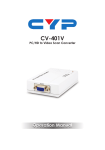Download USER MANUAL
Transcript
K R A ME R E LE CT R O N IC S L T D . USER MANUAL MODEL: VP-690 Presentation Switcher/Scaler P/N: 2900-000704 Rev 3 Contents 1 Introduction 1 2 2.1 Getting Started Achieving the Best Performance 2 2 3 3.1 3.2 3.3 Overview About HDMI—General Description About HDCP Defining the VP-690 Presentation Switcher/Scaler 3 4 5 5 4 Installing in a Rack 8 5 Connecting the VP-690 6 6.1 6.2 6.3 6.4 6.5 Controlling the VP-690 Controlling via the Front Panel Buttons Using the OSD Menu Connecting to the VP-690 via RS-232 Controlling via the ETHERNET Controlling via the Infrared Remote Control Transmitter 11 11 11 14 14 17 7 7.1 8 Technical Specifications Default Communication Parameters RS-232 Communication Protocol 18 18 19 9 Figures Figure 1: VP-690 Presentation Switcher/Scaler Front Panel Figure 2: VP-690 Presentation Switcher/Scaler Rear Panel Figure 3: Connecting the VP-690 Presentation Switcher/Scaler Figure 4: Local Area Connection Properties Window Figure 5: Internet Protocol (TCP/IP) Properties Window Figure 6: Infrared Remote Control Transmitter 6 7 10 15 16 17 VP-690 – Contents i U U U U U U U U U U U U 1 Introduction Welcome to Kramer Electronics! Since 1981, Kramer Electronics has been providing a world of unique, creative, and affordable solutions to the vast range of problems that confront the video, audio, presentation, and broadcasting professional on a daily basis. In recent years, we have redesigned and upgraded most of our line, making the best even better! Our 1,000-plus different models now appear in 11 groups that are clearly defined by function: GROUP 1: Distribution Amplifiers; GROUP 2: Switchers and Matrix Switchers; GROUP 3: Control Systems; GROUP 4: Format/Standards Converters; GROUP 5: Range Extenders and Repeaters; GROUP 6: Specialty AV Products; GROUP 7: Scan Converters and Scalers; GROUP 8: Cables and Connectors; GROUP 9: Room Connectivity; GROUP 10: Accessories and Rack Adapters and GROUP 11: Sierra Products. Congratulations on purchasing your Kramer VP-690 Presentation Switcher/Scaler. This product, which incorporates HDMI™ technology, is ideal for: • Projection systems in conference rooms, boardrooms, hotels and churches • Home theater up-scaling VP-690 – Introduction 1 2 Getting Started We recommend that you: • Unpack the equipment carefully and save the original box and packaging materials for possible future shipment • Review the contents of this user manual Use Kramer high performance high resolution cables Use only the power cord that is supplied with this machine i 2.1 Go to http://www.kramerelectronics.com to check for up-to-date user manuals, application programs, and to check if firmware upgrades are available (where appropriate). Achieving the Best Performance To achieve the best performance: • Use only good quality connection cables to avoid interference, deterioration in signal quality due to poor matching, and elevated noise levels (often associated with low quality cables) • Do not secure the cables in tight bundles or roll the slack into tight coils • Avoid interference from neighboring electrical appliances that may adversely influence signal quality • Position your Kramer VP-690 away from moisture, excessive sunlight and dust 2 VP-690 - Getting Started 3 Overview The Kramer VP-690 is a high quality presentation switcher and scaler. It accepts one of nine inputs: one SD/HD/3G-HD SDI signal, two HDMI signals, two computer graphics signals on 15-pin HD connectors, two composite video signals on RCA connectors and two component video (also known as Y, Pb, Pr, Y, Cb, Cr and YUV; compatible with both SD and HD component ) signals on RCA connectors. It scales the video, embeds the audio, and outputs the signal to the HDMI output as well as to a computer graphics output and an RGBHV video output together with a digital audio output and an analog stereo audio output. The VP-690 Presentation Switcher/Scaler: • Has a video bandwidth of up to 2.97Gbps • Is SMPTE 259M, 292M and 424M compliant • Is HDTV compatible and the resolution can be up- or down-scaled The resolutions which can be selected include: 480i, 480p, 576i, 576p, 720p, 1080i, 1080p, WXGA, WSXGA, WUXGA, NATIVE, VGA, SVGA, XGA, SXGA UXGA, 1280x800, WXGA+, 1600x900, 2048x1080@50 and 2048x1080@60 • Is HDCP Compliant - The HDCP (High Definition Content Protection) license agreement allows copy-protected data on the HDMI input to pass only to the HDMI output • Has analog audio inputs which include volume control, and digital (S/PDIF) and analog stereo audio outputs • Automatically detects and selects the audio source for the HDMI input. Default selection is HDMI – if this is not present, then the machine uses the audio from the analog input • Comes with an On-Screen Display (OSD) for easy setup and adjustment, accessible via the IR remote control and via the front-panel buttons • Has a non-volatile memory that retains the last settings used • Supports firmware upgrade via RS-232 VP-690 – Overview 3 Control your VP-690: • Directly, via the front panel push buttons • By RS-232 serial commands transmitted by a touch screen system, PC, or other serial controller • Remotely, from the infrared remote control transmitter • Via the Ethernet The VP-690 is housed in a 19” 1U rack mountable enclosure, with rack “ears” included, and is fed from a 100-240V AC universal switching power supply. 3.1 About HDMI—General Description High-Definition Multimedia Interface (HDMI) is an uncompressed all-digital audio/video interface, widely supported in the entertainment and home cinema industry. HDMI ensures an all-digital rendering of video without the losses associated with analog interfaces and their unnecessary digital-to-analog conversions. It delivers the maximum high-definition image and sound quality in use today. Note that Kramer Electronics Limited is an HDMI Adopter and an HDCP Licensee. HDMI, the HDMI logo and High-Definition Multimedia Interface are trademarks or registered trademarks of HDMI licensing LLC. In particular, HDMI: • Provides a simple interface between any audio/video source, such as a settop box, DVD player, or A/V receiver and video monitor, such as a digital flat LCD / plasma television (DTV), over a single lengthy cable SIMPLICITY - With video and multi-channel audio combined into a single cable, the cost, complexity, and confusion of multiple cables currently used in A/V systems is reduced LENGTHY CABLE - HDMI technology has been designed to use standard copper cable construction at up to 15m • Supports standard, enhanced, high-definition video, and multi-channel digital audio on a single cable MULTI-CHANNEL DIGITAL AUDIO - HDMI supports multiple audio formats, from standard stereo to multi-channel surround-sound. HDMI has the capacity to support Dolby 5.1 audio and high-resolution audio formats 4 VP-690 - Overview • Transmits all ATSC HDTV standards and supports 8-channel digital audio, with bandwidth to spare to accommodate future enhancements and requirements • Benefits consumers by providing superior, uncompressed digital video quality via a single cable, and user-friendly connector HDMI provides the quality and functionality of a digital interface while also supporting uncompressed video formats in a simple, cost-effective manner • Is backward-compatible with DVI (Digital Visual Interface) • Supports CEC, two-way communication between the video source (such as a DVD player) and the digital television, enabling new functionality such as automatic configuration and one-button play • Has the capacity to support existing high-definition video formats (720p, 1080i, and 1080p, 2K and 4K), standard definition formats such as NTSC or PAL, as well as 480p and 576p 3.2 About HDCP 10B The High-Bandwidth Digital Content Protection (HDCP) standard developed by Intel, protects digital video and audio signals transmitted over DVI or HDMI connections between two HDCP-enabled devices to eliminate the reproduction of copyrighted material. To protect copyright holders (such as movie studios) from having their programs copied and shared, the HDCP standard provides for the secure and encrypted transmission of digital signals. 3.3 Defining the VP-690 Presentation Switcher/Scaler 1B This section defines the VP-690. VP-690 – Overview 5 6 Figure 1: VP-690 Presentation Switcher/Scaler Front Panel # 1 Feature IR Receiver Function Receives signals from the remote control transmitter 2 CV Press to select the composite video input (from 1 to 2) 3 COMPONENT Press to select the component video input (from 1 to 2) 4 5 INPUT SELECTOR PC Buttons HDMI 6 SDI Press to select the computer graphics input (from 1 to 2) Press to select the HDMI input (from 1 to 2) Press to select the SDI input 7 BLANK Button Press to toggle between a blank screen (blue or black screen) and the display 8 MUTE Button Press to toggle between muting (blocking out the sound) and enabling the audio output 9 FREEZE Button Press to freeze/unfreeze the output video image Can be programmed to follow MUTE (see Section 6.2.3) VP-690 – Overview 10 MENU Button Displays the OSD menu (see Section 6.2) 11 ENTER Button Press to accept changes and change the SETUP parameters (see Section 6.2) 12 - Button Press to decrease numerical values or select from several definitions. For convenience and speed—when not working in the OSD—press to reduce volume 13 Button Press to move up the menu list values (see Section 6.2) 14 + Button Press to increase numerical values or select from several definitions. For convenience and speed—when not working in the OSD—press to increase volume 15 Button Press to move down the menu list(see Section 6.2) 16 RESET TO XGA/720p Button Press to reset the video resolution to XGA or 720p Press and hold for about 2 seconds to reset to XGA; or press and hold for about 5 seconds to reset to 720p 17 PANEL LOCK Button Press and hold (for about 2 seconds) to lock/unlock the front panel buttons VP-690 – Overview Figure 2: VP-690 Presentation Switcher/Scaler Rear Panel # Feature SDI IN BNC 18 Function Connect to the SDI source 19 SDI OUT BNC Connect to an SDI acceptor (loop output for the SDI input) 20 PC 15-pin HD Connect to the computer graphics source (from 1 to 2) 21 HDMI Connect to the HDMI source (from 1 to 2) CV RCA Connect to the composite video source (from 1 to 2) 22 VIDEO INPUT Connectors 23 COMP PR RCA 24 COMP PB RCA 25 COMP Y RCA 26 Connect to the component video source (from 1 to 2) HDMI Connect to the analog audio HDMI source (from 1 to 2) SDI Connect to the analog audio SDI source PC Connect to the analog audio computer graphics source (from 1 to 2) CV Connect to the analog audio composite video source (from 1 to 2) COMP Connect to the analog audio component video source (from 1 to 2) L Connect to the left stereo analog audio acceptor R Connect to the right stereo analog audio acceptor 30 S/PDIF Connect to a digital audio acceptor 31 H BNC 32 V BNC 27 28 29 AUDIO INPUTS Unbalanced Stereo Terminal Block Connectors AUDIO OUTPUTS RCA Connectors 33 34 R BNC VIDEO OUTPUT Connectors Connect to the RGBHV video acceptor G BNC 35 B BNC 36 HDMI Connect to the HDMI acceptor 37 PC 15-pin HD Connect to a VGA acceptor 7 38 RS-232 9-pin D-sub Port Connect to the PC or the remote controller 39 ETHERNET Connector Connects to the PC or other Serial Controller through computer networking 40 Power Connector with Fuse AC connector, enabling power supply to the unit 41 POWER Switch Illuminated switch for turning the unit ON or OFF 4 Installing in a Rack This section provides instructions for rack mounting the unit. 8 VP-690 - Installing in a Rack 5 Connecting the VP-690 ! i Always switch off the power to each device before connecting it to your VP-690. After connecting your VP-690, connect its power and then switch on the power to each device. You do not have to connect all the inputs and outputs, connect only those that are required. To connect the VP-690, as illustrated in the example in Figure 3, do the following: 1. Connect an SDI source (for example, a non linear editor) to the SDI IN BNC connector. 2. Connect the SDI OUT BNC connector to an SDI acceptor (for example, an SDI display). 3. Connect an HDMI source (for example, a DVD player) to the HDMI 1 VIDEO INPUT connector. Alternatively, you can connect the DVI connector on the DVD player to the HDMI connector on the VP-690 via a DVI-HDMI adapter. When using this adapter, you can connect the audio signal via the terminal block connector 4. Connect a computer graphics source to the PC 1 15-pin HD VIDEO INPUT connector. 5. Connect a composite video source (for example, a composite video player) to the CV 1 VIDEO INPUT RCA connector. 6. Connect a component video source (for example, a component video player) to the COMP 1 PR, PB and Y, VIDEO INPUT RCA connectors. 7. Connect the audio input signals to the AUDIO INPUT terminal block connectors, as required (not shown in Figure 3). 8. Connect the RGBHV VIDEO OUTPUT BNC connectors to an RGBHV acceptor (for example, an RGBHV display). VP-690 - Connecting the VP-690 9 9. Connect the HDMI VIDEO OUTPUT connector to an HDMI acceptor (for example, a plasma display). 10. Connect the VGA VIDEO OUTPUT 15-pin HD connector to a VGA acceptor (for example, a projector). 11. Connect the audio output signals to the AUDIO OUTPUTS stereo analog audio acceptor and/or the digital audio acceptor, as required (not shown in Figure 3). 12. Connect the power cord (not shown in Figure 3). 13. If required, connect: A PC via RS-232, see Section 6.3 The ETHERNET port, see Section 6.4 Figure 3: Connecting the VP-690 Presentation Switcher/Scaler 10 VP-690 - Connecting the VP-690 6 Controlling the VP-690 The VP-690 can be controlled via: • The front panel buttons (see Section 6.1) • The OSD menu (see Section 6.2) • RS-232 serial commands transmitted by a touch screen system, PC, or other serial controller (see Section 6.3) 6.1 • The ETHERNET (see Section 6.4) • The infrared remote control transmitter (see Section 6.5) Controlling via the Front Panel Buttons The VP-690 includes the following front panel buttons: • Input selector buttons for selecting the required input: CV (1 and 2), COMPONENT (1 and 2), PC (1 and 2), HDMI (1 and 2), or SDI 6.2 • BLANK, MUTE and FREEZE buttons • MENU, ENTER, and arrow buttons (up, down, left and right) • RESET TO XGA/720p and PANEL LOCK buttons Using the OSD Menu The control buttons let you control the VP-690 via the OSD menu. Press the: • MENU button to enter the menu The default timeout is set to 10 seconds • ENTER button to accept changes and to change the menu settings • Arrow buttons to move through the OSD menu, which is displayed on the video output On the OSD menu, select EXIT to exit the menu. VP-690 - Controlling the VP-690 11 6.2.1 The MAIN MENU Mode CONTRAST Function Set the contrast The range and default values vary according to the input signal BRIGHTNESS Set the brightness The range and default values vary according to the input signal FINETUNE (see Section 6.2.2) COLOR Set the red, green and blue shades SIZE Select the size of the display: FULL, OVERSCAN, UNDER1, UNDER2, LETTER BOX, PANSCAN (default, FULL) UNDER1 refers to an underscan of 6% and UNDER2 refers to an underscan of 9% SOURCE OUTPUT Select the source (default VGA): Source input Appears as: Source input Appears as: CV 1 AV1 VGA 2 PC 2 CV 2 AV2 HDMI 1 HDMI 1 COMP 1 YPBPR 1 HDMI 2 HDMI 2 COMP 2 YPBPR 2 SDI SDI VGA 1 PC 1 Select the output resolution from the menu (default NATIVE): Output resolution: Appears as: Output resolution: Appears as: 480i 480I 1024x768 XGA 480p 480P 1280x1024 SXGA 720p @50Hz 720P60 1600x1200 UXGA 1080i @60Hz 1080I60 1366x768 WXGA 1080p @60Hz 1080P60 1680x1050 WSXGA 576i 576I 1920x1200 WUXGA 576p 576P 1280x800 1280x800 720p @50Hz 720P50 1440x900 WXGA+ 1080i @50Hz 1080I50 1400x1050 SXGA+ 1080p @50Hz 1080P50 2048x1080@50 2K50 NATIVE 2048x1080@60 2K60 640x480 VGA 1600x900 1600x900 800x600 SVGA Select “NATIVE” to select the output resolution from the EDID of the connected HDMI monitor AUDIO See Section 6.2.3 OSD Set the OSD parameters: H POSITION, V POSITION, TIMER, BACKGROUND and DISPLAY (see Section 6.2.4) FACTORY RESET 12 Resets to the default parameters (the resolution is set to XGA or 720p) If you cannot see the display after factory reset, use the front panel Res. button to set the correct resolution: press continuously for 2 seconds to reset to XGA, or continuously for 5 seconds to reset to 720p INFORMATION Displays the source, the input resolution, the output resolution and the software version AUTO SYNC Turn the auto sync ON/OFF. When ON, a short period after not detecting a valid video signal on the selected input, the unit will disable the H and V syncs on the analog outputs until a valid input is again detected EXIT Select to exit the menu VP-690 - Controlling the VP-690 6.2.2 The FINETUNE Menu Input Signal CV, COMPONENT Parameter HUE Function Set the color hue SATURATION Set the color saturation SHARPNESS Set the sharpness of the picture NOISE REDUCTION Select the noise reduction: OFF, HI, LOW and MID (middle) COLOR FILTER VGA HDMI i 6.2.3 Set to ON to enable color filtering PHASE Set the clock phase CLOCK Set the clock frequency H-POSITION Set the horizontal position of the picture V-POSITION Set the vertical position of the picture AUTO TUNE When set to ON, auto adjusts the image (centers it correctly on the screen) every time the input is switched to VGA or when the input resolution changes COLOR FILTER Set to ON to enable color filtering COLOR FILTER Set to ON to enable color filtering COLOR FILTER may improve the output image for certain graphic cards where color fringing is seen. The AUDIO Menu Parameter OUTPUT VOLUME INPUT VOLUME Function Set the output volume (from 0 to 100) Not applicable for embedded HDMI and SDI audio inputs Set the input volume (from 0 to 100) Not applicable for embedded HDMI and SDI audio inputs DELAY Select the audio delay time: OFF, 40ms, 110ms and 150ms SOUND Select the sound options: ON, MUTE MUTE FOLLOWS Select the action that will be followed by mute: INDEPENDENT - the audio muting is independent of the FREEZE and BLANK functions FREEZE BLANK FREEZE/BLANK - when you FREEZE or BLANK the video, the audio will be muted (the MUTE function follows the FREEZE and the BLANK functions) HDMI AUDIO IN Select: AUTOMATIC - the embedded audio on the HDMI input is selected for an HDMI signal, or the analog audio input is selected if the input is not HDMI (for example, for a DVI input signal) EMBEDDED - the embedded audio in the HDMI signal is selected ANALOG - the analog audio input is selected i HDMI AUDIO IN is enabled only when one of the HDMI inputs is selected. VP-690 - Controlling the VP-690 13 6.2.4 The OSD Menu Parameter H POSITION Function Set the horizontal position of the OSD (from 0 to 100) V POSITION Set the vertical position of the OSD (from 0 to 100) TIMER Set the timeout period in seconds (from 5 to 100) BACKGROUND Set the OSD background between 0 (solid black) and 8 (transparent) DISPLAY 6.3 Select the information shown on the screen during operation: ON - the information is shown permanently OFF - the information is not shown INFO - the information is shown for a few seconds Connecting to the VP-690 via RS-232 You can connect to the VP-690 via an RS-232 connection using, for example, a PC. Note that a null-modem adapter/connection is not required. To connect to the VP-690 via RS-232, connect the RS-232 9-pin D-sub rear panel port on the VP-690 unit via a 9-wire straight cable (only pin 2 to pin 2, pin 3 to pin 3, and pin 5 to pin 5 need to be connected) to the RS-232 9-pin D-sub port on your PC. 6.4 Controlling via the ETHERNET You can connect the VP-690 via the Ethernet, using a crossover cable (see Section 6.4.1) for direct connection to the PC or a straight through cable (see Section 6.4.2) for connection via a network hub or network router. i 6.4.1 After connecting the Ethernet port, you have to install and configure your Ethernet Port. For detailed instructions, see the “Ethernet Configuration (FC-11) guide.pdf” file in the technical support section on our Web site. Connecting the ETHERNET Port Directly to a PC (Crossover Cable) You can connect the Ethernet port of the VP-690 to the Ethernet port on your PC, via a crossover cable with RJ-45 connectors. i 14 This type of connection is recommended for identification of the factory default IP Address of the VP-690 during the initial configuration. VP-690 - Controlling the VP-690 After connecting the Ethernet port, configure your PC as follows: 1. Right-click the My Network Places icon on your desktop. 2. Select Properties. 3. Right-click Local Area Connection Properties. 4. Select Properties. The Local Area Connection Properties window appears. 5. Select the Internet Protocol (TCP/IP) and click the Properties Button (see Figure 4). Figure 4: Local Area Connection Properties Window 6. Select Use the following IP Address, and fill in the details as shown in Figure 5. 7. Click OK. VP-690 - Controlling the VP-690 15 Figure 5: Internet Protocol (TCP/IP) Properties Window 6.4.2 Connecting the ETHERNET Port via a Network Hub (StraightThrough Cable) You can connect the Ethernet port of the VP-690 to the Ethernet port on a network hub or network router, via a straight-through cable with RJ-45 connectors. 16 VP-690 - Controlling the VP-690 6.5 Controlling via the Infrared Remote Control Transmitter Keys SIZE CV1 COMP2 HDMI1 POWER CV2 PC1 HDMI2 INFO PC2 SDI EXIT FREEZE BLANK POWER Set the size of the image displayed Turn the VP-690 ON or OFF OFF in this case means that the unit is in standby mode COMP1 NATIVE MENU SIZE Function CV1 Select the composite video 1 input CV2 Select the composite video 2 input COMP1 Select the component video 1 input COMP2 Select the component video 2 input PC1 Select the UXGA 1 input PC2 Select the UXGA 2 input HDMI1 Select the HDMI1 input HDMI2 Select the HDMI2 input SDI Select the SDI input XGA Reset Reset the resolution to XGA 720p Reset Reset the resolution to 720p INFO Displays the selected input, the input and output resolutions and the firmware versions on the OSD NATIVE Select the output resolution via the EDID of the connected HDMI monitor MUTE Four navigation keys Left and right arrow keys also function as output volume control OK LR-34 Figure 6: Infrared Remote Control Transmitter VP-690 - Controlling the VP-690 Press to accept changes MENU Enter the OSD menu EXIT EXIT the menu FREEZE Freeze/unfreeze the output video image BLANK Toggle between a blank screen (blue or black screen) and the display MUTE Toggle between muting (blocking out the sound) and enabling the audio output 17 7 Technical Specifications INPUTS: 1 3G-HD-SDI on a BNC connector 2 HDMI connectors (HDMI, HDCP version 1.1) 2 VGA on a 15-pin HD connector 2 composite video on RCA connectors 2 component video each on 3 RCA connectors 2 HDMI, 2 PC, 2 COMP, 1 CV 1SDI unbalanced stereo audio on terminal block connectors OUTPUTS: 1 3G-HD-SDI on a BNC connector 1 RGBHV on 5 BNC connectors 1 HDMI connector (HDMI, HDCP version 1.1) 1 VGA on a 15-pin HD connector 1 S/PDIF on an RCA connector 1 analog stereo audio on 2 RCA connectors MAX. OUTPUT LEVEL: VIDEO: 0.7Vpp BANDWIDTH (-3dB): VIDEO: UXGA AUDIO: 3.4Vpp @1kHz AUDIO: 22.5kHz OUTPUT RESOLUTIONS: 480i, 480p, 720p60, 1080i60, 1080p60, 576i, 576p, 720p50, 1080i50, 1080p50, NATIVE, VGA, SVGA, XGA, SXGA, UXGA, WXGA, WSXGA, WUXGA, 1280x800, WXGA+, SXGA+, 1600x900, 2048x1080@50, 2048x1080@60 S/N RATIO: AUDIO: 87.8dB @1kHz, “A” weighting CROSSTALK (all hostile): VIDEO: -54dB CONTROLS Input selector buttons: CV1, CV2, component 1, component 2, PC 1, PC 2, HDMI 1, HDMI 2, SDI. Blank, mute, freeze, reset to XGA/720p, panel lock. Menu functions: menu, enter, menu arrows. RS-232, Ethernet, IR AUDIO: -70dB @20kHz COUPLING VIDEO: DC AUDIO THD + NOISE: 0.015% @1kHz, “A” weighting AUDIO 2nd HARMONIC: 0.01% @1kHz POWER SOURCE: 100-240V AC, 29VA max. DIMENSIONS: 19-inch (W), 7-inch (D) 1U (H) rack mountable WEIGHT: 2.7kg (6lbs) approx ACCESSORIES: Power cord, rack ears, IR remote control transmitter AUDIO: AC Specifications are subject to change without notice at http://www.kramerelectronics.com 7.1 Default Communication Parameters RS-232 Communication Protocol Baud Rate: 9600 Data Bits: 8 Stop Bits: 1 Parity: None Command Format: HEX Example (Select HDMI1 input): Y026CR Ethernet 18 IP Address: 192.168.1.39 TCP Port Number: 5000 Network Mask: 255.255.255.0 Default Gateway: 192.168.1.1 VP-690 - Technical Specifications 8 RS-232 Communication Protocol The following is the COM port setting: Baud Rate: 9600bps Parity: None Data Bits: 8bits Stop Bits: 1bit Set CTS Mode: Off Set XON/XOFF: Off Character Symbols Definitions Meaning Space [CR] Carriage Return, ASCII code 0x0D [LF] or > Line Feed, ASCII code 0x0A Symbol Set and Get Command Set Command: Type in : YControl_TypeFunctionParamCR Reply: ZControl_TypeFunctionParamCRDone>CR Get Command: Type in : YControl_TypeFunctionCR Reply: ZControl_TypeFunctionParamCR Example: Example 1: set brightness value as 32 Send: Y11632[CR] Reply: Z11632[CR][LF] Example 2: get current output resolution. (2 = SVGA) Send: Y421[CR] Reply: Z4212[CR][LF] VP-690 - RS-232 Communication Protocol 19 20 Control Type 0 0 Param (for Set) N/A 0 1 N/A POWER button on remote control 0 2 N/A FREEZE button on remote control 0 3 N/A 480p button on remote control 0 4 N/A 576p button on remote control 0 5 N/A 720p button on remote control 0 6 N/A 1080i button on remote control 0 7 N/A 1080p button on remote control 0 8 N/A VGA button on remote control 0 9 N/A SVGA button on remote control 0 10 N/A XGA button on remote control 0 11 N/A SXGA button on remote control 0 12 N/A WXGA button on remote control 0 13 N/A UXGA button on remote control 0 14 N/A INFO button on remote control 0 15 N/A UP button on remote control 0 16 N/A NATIVE button on remote control 0 17 N/A LEFT button on remote control 0 18 N/A OK button on remote control 0 19 N/A RIGHT button on remote control 0 20 N/A MENU button on remote control 0 21 N/A DOWN button on remote control 0 22 N/A EXIT button on remote control 0 23 N/A AV 1 button on remote control 0 25 N/A COMP1 button on remote control 0 26 N/A HDMI1 button on remote control 0 27 N/A HDMI2 button on remote control 0 28 N/A COMP2 button on remote control 0 29 N/A PC 1 button on remote control 0 30 N/A BLANK button on remote control Function Function Description Comment SIZE button on remote control VP-690 - RS-232 Communication Protocol Control Type Function Param (for Set) Function Description Comment 0 31 N/A MUTE button on remote control 0 33 N/A Auto adjust 0 34 N/A AV2 button on remote control 0 35 N/A PC2 button on remote control 0 38 N/A SDI in button on remote control 1: Set 2: Get 4 0~100 Color: Red 1: Set 2: Get 5 0~100 Color: Green 1: Set 2: Get 6 0~100 Color: Blue 1: Set 2: Get 16 0~100 Brightness 1: Set 2: Get 17 0~100 Contrast 1: Set 2: Get 25 0~100 Hue 1: Set 2: Get 26 0~100 Sharpness 1: Set 2: Get 29 0~100 Saturation 1 : SET 2 : GET 33 0~100 Set an absolute volume for Output 1 : SET 2 : GET 34 0~100 Set an absolute volume for Input 1: Set 2: Get 41 0~100 OSD Setting :H-Position 1: Set 2: Get 42 0~100 OSD Setting: V-Position 1: Set 2: Get 43 0~100 OSD Timeout 1: Set 2: Get 44 0~8 OSD Background 1: Set 2: Get 50 0~3 NR (Noise Reduction) 0: Off 1: Low 2: Mid 3: High 1: Set 2: Get 51 0~3 Audio delay 0: Off 1: 40ms 2: 110ms 3: 150ms 1: Set 2: Get 52 0~2 HDMI AUDIO IN 0 : AUTOMATIC 1 : EMBEDDED 2 : ANALOG 1: Set 2: Get 84 0~1 Auto Sync Off VP-690 - RS-232 Communication Protocol FW V6.12 0 : OFF (FW:6.14) 1 : ON 21 Control Type 3: Set 4: Get 3: Set 4: Get 22 Function 0 1 Param (for Set) 1~11 0~5 Function Description Comment Select Input Source 1: AV 1 2: AV 2 3: COMP1 4: COMP2 5: PC 1 6: PC 2 7: HDMI1 8: HDMI2 11: SDI Size 0: Full 1: Panscan 2: Overscan 3: Underscan 4: Letterbox 5: Underscan2 0: Native 1: VGA 2: SVGA 3: XGA 4: SXGA 5: UXGA 6: 480i 7: 480p 8: 720p60 9: 1080i60 10: 1080p60 11: 576i 12: 576p 13: 720p50 14: 1080i50 15: 1080p50 16: WXGA 17: WSXGA 18: WUXGA 19: 1280x800 20: WXGA+ (1440X900) 21: SXGA+ (1400X1050) 22: 1600x900 23: 2048x1080/50 24: 2048x1080/60 3: Set 4: Get 21 0~24 Output Resolution 3: Set 23 1 Factory Reset 6: Set 7: Get 0 0~2 Power 0: Power Down 1: Power On 2: Reboot 6: Set 7: Get 1 0~1 Freeze 0: Off 1: On 6: Set 7: Get 2 0~1 Blank 0: Off 1: On 6: Set 7: Get 3 0~1 Mute 0: Off 1: On VP-690 - RS-232 Communication Protocol Control Type Function Param (for Set) Function Description Comment 6: Set 7: Get 4 0~1 Key lock 0: Off 1: On 6 : set 7 : get 140 0~1 Auto Tune (under fine tune) 0 : Clear Auto Tune 1 : Set Auto Tune VP-690 - RS-232 Communication Protocol 23 For the latest information on our products and a list of Kramer distributors, visit our Web site where updates to this user manual may be found. We welcome your questions, comments, and feedback. Web site: www.kramerelectronics.com E-mail: [email protected] ! SAFETY WARNING Disconnect the unit from the power supply before opening and servicing














































